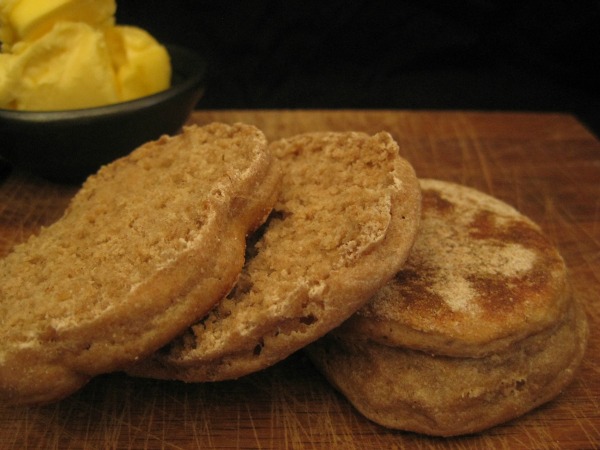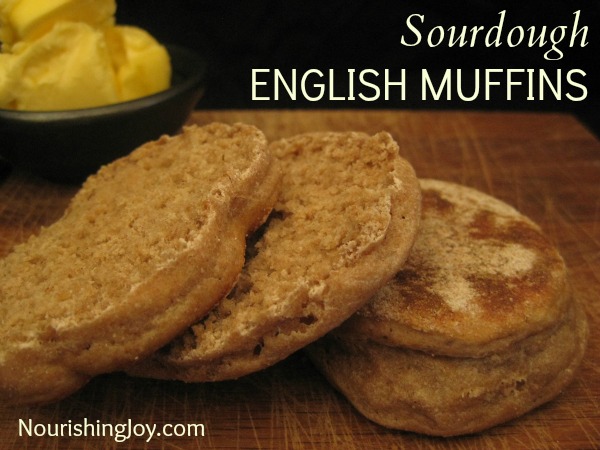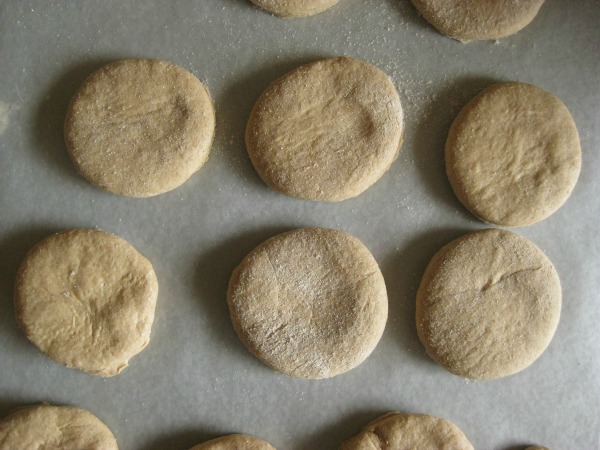Sourdough English Muffins
This post may contain affiliate links, including those from Amazon.com, which means we earn a small commission off your purchases. And here's the thing: We only mention services and products that we think are truly worth your attention, whether they're free, paid, or otherwise. This site relies on YOUR trust, so if we don't stand behind a product 110%, it's not mentioned. Period.
Due to my love of sourdough, I've been wanting to make a sourdough version of English muffins for quite some time, but it's been one of those projects I just haven't gotten to.
However, when I finally made them for brunch a few months ago, I realized it's far from a “project.” It's just about the easiest bread baking I've ever done!
Making English muffins requires no oven and uses the “discarded” starter left over from your nightly sourdough feeding. (I'm always looking for ways to use the extra starter, since I don't want to actually throw it away. Hello… sustainable living, anyone?)
And these are scrumptious, especially slathered with butter and jam. Once you've made a batch, you'll want to make them again and again. Sourdough English muffins are homey comfort food at its best.
Oh, and I'm listing several of the ingredients by weight, merely because I find it's the best way to keep the results consistent, but the volume measurements certainly work as well.
Sourdough English Muffins
Makes approximately 18 muffins
For the sponge:
150 g (~ 1 1/2 cups) sourdough starter
260 g (~1 3/4 cups) spelt flour (if using all-purpose flour, use slightly more)
275 g (~1 1/8 cups) whole milk
For the dough:
100 g (~7/8 cup) spelt flour (if using all-purpose flour, use slightly less)
3/4 teaspoon sea salt
1 teaspoon baking soda
1 tablespoon raw honey
Method:
First make the sponge: In a medium glass or Pyrex bowl, mix all the ingredients for the sponge. The mixture will be rather shaggy. Cover and let sit at room temperature for 6-12 hours.
Make the muffins: Scrape the sponge into the bowl of an electric mixer fitted with the dough hook and add the remaining dough ingredients. Alternatively, to mix by hand, combine everything in the bowl with the sponge. Knead the dough for 5-6 minutes on low speed until the dough is very soft but no longer sticky.
(Optional: If you want extra nooks and crannies in your English muffins, let the dough rise at this point until it's doubled in size, about 1 1/2 hours, then punch down and proceed.)
Turn the dough out on a well-floured surface and pat it until it's about 1/2″ inch thick. Use a 3-inch biscuit cutter or decorative cookie cutter and cut the dough into circles. Place the circles on a sheet of parchment paper, silicone liner, or other non-stick surface.
Cover with a tea towel and let rise for 45-60 minutes.
Preheat a dry griddle over medium-low heat until it's fully heated, about 5 minutes. Place as many muffins as fit comfortably on the griddle and cook for about 8 minutes, flipping every minute or two. The finished muffins will be nicely browned and the sides will be firm.
Slice with a serrated knife or split them open using a fork to get a more rustic texture.








This muffin recipe sounds delicious, I love using spelt flour. Thanks!
I dont understand the measurements ..what would 11/2 cups be?
Hanna,
The weight measurement is right in front of the volume measurement – the “~” merely means “approximately”. So I simply mean that if you’re weighing your ingredients, use 150 grams, and if you’re using a measuring cup, scoop out 1 1/2 cups of starter. To measure by volume, just stir the starter, then scoop the starter until it’s overflowing in the cup, then use a knife to scrape off the excess.
Does that help? Or did I misunderstand your question?
Where do you get the starter?
Either from a friend who can pass a bit off, from Cultures for Health, or you can make your own.
How to Make Your Own Sourdough Starter –> http://nourishedkitchen.com/how-to-make-a-sourdough-starter/
Have fun!
Kresha,
Thank you for inspiring me to try english muffins.
I’d like to share the easy way my 6 year old son taught me to find a good sourdough starter:
Take about one cup of flour and add only enough water to make a dry dough as you would for making a Christmas tree ornament. Flatten it like an english muffin. Cover loosely with something to slow it from drying out, but still allowing some air to get in. After about 5 days or a week you’ll see if it has a strong yeast culture in it by how fat it puffs up. I like to take several types of flour and do this to each one. I’ll bake one loaf with each of the strongest cultures and only keep the best. No feeding is required until you decide to bake with them and make your sponge out of the inner wetter part of your dough balls.
Kresha,
Thank you so much for this recipe. I’ve been making soaked-flour english muffins for awhile, which are great. But I just started feeding a sourdough starter and was excited to try your recipe with some of my excess starter. They turned out beautifully! I fork-split them and toasted them for a few minutes, because they were still a bit doughy inside, but I have to do that with the soaked ones, too. My three boys and I just had them for breakfast, and my oldest (6 years old) declared them the best english muffins he’s ever had (He’s so enthusiastic he started talking about opening a bakery so we can make them for everyone – for free! So sweet!)
I read a couple of different nourishing food/home blogs regularly, but just recently started exploring yours. Thank you for providing so many wonderful recipes and resources – I’ve signed up for your updates and bookmarked your site for several things, including this recipe.
Maria
Maria,
Thank you for your kind words. I’m so glad you enjoyed the English muffins. We certainly do too.
Please tell your son that when he opens his bakery, I’ll be first in line. 🙂
We are gluten free. Have you tried them with other flours? Any suggestions? Thanks
No, I’m sorry, I haven’t tried them with any gluten-free flours.
Perhaps if other readers have experimented they could chime in with their experiences…. anyone? 😉
Hi! I recently found a sourdough cashew bread from Urban Poser that is gluten free and grain free (and one that I reallllly want to try!); it uses probiotic capsules from the health food store to get the soured taste instead of fermenting a grain. However, if you’re in the mood for a little more adventure in the kitchen, here are a few gluten free sourdough starter recipes (courtesy of a quick Google search):
– http://wholenewmom.com/recipes/gluten-free-sourdough-starter/
– http://www.intentionallydomestic.com/how-to-make-a-sourdough-starter/
– http://www.artofglutenfreebaking.com/2010/10/sourdough-starter-gluten-free/
– http://www.naturalfertilityandwellness.com/how-to-gluten-free-starter/
I’m hoping that each of these sites will include a sourdough bread recipe as well, since they did all of the work to post a starter. Best of luck!!!
Also, Kresha, thanks for the sourdough recipe! My husband loves sourdough, and I love the gut-goodness it provides. Making this now and loving that it incorporates spelt flour (other than a few rice varietals, the only grain I currently have!). 🙂
may i ask what “shaggy” means? 🙂
mine looks like batter.. my starter was pretty thick.. is the “sponge” supposed to resemble pancake batter?
much appreciated! i’m looking forward to these yummy muffins tomorrow!
♥
“Shaggy” just refers to the appearance of the dough. It’s definitely a dough (meaning, not pourable!), but very soft and not smooth like bread dough.
As for the sponge, I’m not sure what your pancake batter tends to look like, but mine is very thick yet still pourable – and yes, that would describe the sponge too. 🙂
I hope your muffins turned out great!
YAY! i used sprouted wheat flour, and had to add more than 7/8 of a cup, but it all came together beautifully. The muffins are delicious.. and i got the idea randomly to form some of the dough into pretzels, then soaked them in hot-water for a minute before throwing them on a pan and topping them with some melted coconut oil and flaky sea salt, in the oven for 12 minutes and YUM.. this dough made great soft pretzels.. many mouths here agreed! 🙂
Mmm…. now you’ve got me drooling! Thanks for sharing! 🙂
So I going to try this, but right off the bat, I have a problem. I scooped out 1+ 1/2 cups starter. Then I decided to weigh for good measure. 150 g is only about 3/4 c. Of my starter. I feed with AP flour. In equal parts. So if I have 50 g starter, I feed 50 g AP flour and 50 g. water.
I’m going by weight for now, but I am nervous…
Going by weight is always a good idea, as volume can vary so much! Let us know how it goes. 🙂
I have used this as a base recipe probably a dozen times, but I must say that I use Bob’s Red Mill spelt flour and I use WAY more than 7/8 cup flour for the dough. I have found that, typically, I use more spelt flour than recipes call for, especially when substituting spelt for AP flour. The couple of times I have tried using less than 2 cups of spelt for the dough, it has been so sticky that cutting out circles, or removing them from the parchment paper where I let them rise, is very difficult. This last time I used probably 2 1/4 c. spelt flour. But they are totally delicious! I make this recipe on average at least once a month, and freeze any extras to eat later.
Thank you so much! Yes, flour amounts can vary SO much – I’ve found even when I travel, sometimes at places away from home I’ll use more than twice what I use at home, so knowing the proper feel – as you’ve described – is the more important than following accurate measurements.
Thanks for a great point and sharing how they work best for you!
Great muffin recipe thanks. Much better than the one I tried last week. Just made them and they turned out really well. Nice soft airy dough. Will use this recipe from now on ! Like the fact that it is sourdough and has no lard, eggs etc.